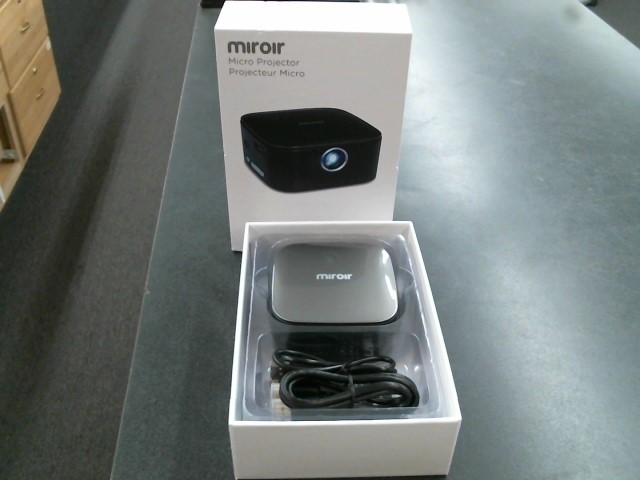

The Miroir M55 Micro Pocket Projector has an HDMI input that allows you to connect desktop computers, laptops, phones and tablets (although these may require an adapter), or also connect streaming devices like Apple TV, Roku, or ChromeCast amongst others. But any way you slice it, it’s not a high definition image but the M55 can accept an HD signal over HDMI although the resulting projection will be in 640 x 360 resolution. “Standard definition” is generally accepted as 640 x 480 but that is at a 4:3 aspect ratio so 640 x 360 reflects 16:9.

The resolution available is 640 x 360 or essentially standard definition (SD) which is below high definition (HD). How far from the wall or screen the unit is set up will determine the size of your projection but the M55 is capable of producing a 50 inch focused image. The image produced is in 16:9 aspect ratio, which is the primary aspect ratio currently available on most televisions and computer monitors. It has a built in battery that can power the device for up to 2 hours while being used and can be recharged over USB. The M55 uses a combination of DLP and LED technologies to ultimately send up to a 50 inch picture from the projection unit to a nearby wall or screen.ĭespite being incredibly small, lightweight, and portable, the M55 Micro Pocket Projector has several nifty features.

LED refers of course to Light Emitting Diode and references the light source used in most of our current electronics. DLP being Texas Instrument’s Digital Light Processing that uses mirrors (often with a spinning colour wheel) to reflect light and was all the rage a decade ago as the shift started from standard definition rear projection TVs to the emerging (circa 2006-ish) breed of HD models. The M55 uses DLP and LED technology for the projection. Weight wise the M55 comes in at only 198 grams or just shy of 7 ounces. The photo above shows it in comparison to my iPhone 6+ in order to give the size some context. You can literally slip this into the pocket of your shirt, pants, or jacket but will likely slip it easily into one of the pockets in your bag, briefcase, or purse.

It measures a miniscule 4.25 inches wide (10.8 cm), 3.1 inches deep (7.9 cm), and when laid out flat, isn’t even ¾ of an inch thick (1.8 cm). The M55 isn’t called a “Micro Pocket Projector” without reason. Miroir Micro Projector specifications next to iPhone The Miroir M55, Micro Pocket Projector is the direct response to that concern. While they certainly did help you with the ability to project images, presentations, or videos onto a screen or wall, there was still a requirement of preparation and space that could ultimately make the spontaneous presentation impossible. The first “mobile” projectors on the market were simply regular projectors that hadn’t been affixed to a ceiling yet and came in a padded carrying case. While many places do have rooms equipped for such an endeavor, most do not and a handy mobile response may have given birth to the dream of a pocket sized projector. Walking cold into any building, business, or office and quickly and effortlessly having the ability to project a presentation is, at best, a coin toss. The idea of mobile projection likely began in response to those professionals who make their living travelling and doing presentations. Well, tomorrow is today and the dream is now a reality as the Miroir(French for mirror if I’m not mistaken) M55 Micro Projector literally puts the power of LED projection in your pocket. Whether watching fantastical YouTube mock ups of mobile phones that could project images onto a nearby surface or reading discussions about pocket sized video projection units, they were still the promise of tomorrow’s tech. When it comes to technological innovation over the past decade, I seem to recall a lot of attention paid to the idea of mobile projecting.


 0 kommentar(er)
0 kommentar(er)
